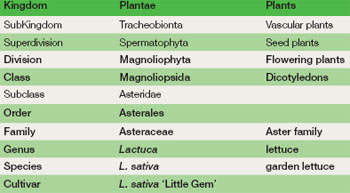Any classification system involves the grouping of organisms or
objects using characteristics common to members within the group.
A classification can be as simple as dividing things by colour or
size. Fundamental to most systems and making the effort worthwhile
is that the classification meets a purpose; has a use. This is generally
to make lifesimpler such as to find books in a library; they can be
classified in different, but helpful ways, e.g. by subject or date or
particular use.
Terms that are used in classification are:
- taxonomy, which deals with the principles on which a classification is
based;
- systematics identifies the groups to be used in the classification;
- nomenclature deals with naming.
Various systems for organisms have been devised throughout history,
but a seventeenth century Swedish botanist,
Linnaeus, laid the basis for
much subsequent work in the classification of plants, animals (and also
minerals). The original divisions of the plant kingdom were the main
groupings of organisms according to their place in evolutionary history.
Simple single-celled organisms from aquatic environments evolved to
more complex descendants, multicellular plants with diverse structures,
which were able to survive in a terrestrial habitat, and develop
sophisticated reproduction mechanisms.
 |
Figure 4.1 A range of divisions of the plant
kingdom , including moss, fern, fungi, seed
producing plants (pine needles) in natural habitat |
The world of living organisms is currently divided into five kingdoms
including:
- Plantae (plants)
- Animalia (animals)
- Fungi
- Bacteria (Prokaryotae)
- Protoctista (all other organisms that are not in the other kingdoms
including algae and protozoa).
The organisms constituting the plant kingdom are distinguishable from
animals in having sedentary growth, cellulose cell walls and polyploidy. They are able to change energy from one form (e.g.
light) into organic molecules (autotrophic nutrition; see photosynthesis). Animals, amongst other things, have no cell walls and rely on
eating ready-made organic molecules (heterotrophic nutrition).
Plant divisions (the names ending in - phyta) are further sub-divided into
- class (ending -psida);
- order (ending -ales);
- family (ending -aceae);
- genus;
- species
 |
Table 4.1 Classification:. The lettuce cultivar ‘Little Gem ’
used to illustrate the hierarchy of the classification up to
kingdom |
Species is the basic unit of classification, and is defined as a group of
individuals with the greatest mutual resemblance, which are able to
breed amongst themselves. A number of species with basic similarities
constitute a genus (plural genera), a number of genera constitute a
family, and a number of families make up an order (see example given
in Table 4.1).
Subspecies are a naturally occurring variation within a
species where the types are quite different from each other.
In order to produce a universally acceptable system, the International
Code of Botanical Nomenclature was formulated, which includes both
non-cultivated plants and details specific to cultivated plants.






